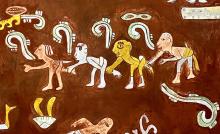cuica (Mdz43r)
This simplex glyph for the verb to sing (cuica), which doubles as the place name Cuicatlan, can have multiple readings, including the noun cuicani (singer) and the noun cuicatl (song). It consists of a human face in profile, looking to the viewer's right. From the open mouth emerges a huge speech scroll with an elaborate design. The scroll is segmented, red and white, with black line drawings.
Stephanie Wood
The elaborate nature of the scroll sets it apart from the regular speech scroll, perhaps a reflection of the appreciation for song. Furthermore, the first two symbols inside the segments (starting at the bottom) are reminiscent of symbols for writing or painting, as shown on folio 70 recto, where a "pintor" writes on a codex. See Mexicolore for this and another image (of a woman) writing/painting. The outside of the scroll of this glyph for cuica has small, white, curling shapes. Ideas about how to interpret these include feathers, a visual representation of sound, or a suggestions of the movement of dance. Scrolls associated with representations of sounds can also be found coming out of drums. See, for example, Valeria Ballomia, "Sound artefacts as containers. The materiality of rhythm in ancient Mesoamerica," Pallas: Revue d'Études Antiques 15 (2021), 121–145, especially section 4.
Other symbols inside the large scroll here may include shells, including the turbinate shell that appears so often splashing off from a stream of water. See the examples of the shells called cilin and cuechtli, below. Jeanette Peterson (The Paradise Garden Murals of Malinalco, 1993, 47) identifies a song scroll in the Malinalco murals, and in it she identifies the ilhuitl sign (which also stands for writing and the tonalamatl), the shell, and a flower. So, in content, it is very similar to this glyph.
Stephanie Wood
c. 1541, but by 1553 at the latest
Stephanie Wood
singing, songs, singers, speech scrolls, volutas, canciones, cantadores
This is a detail of a reproduction of a mural at the archaeological site of Tepantitla, Teotihuacan. The reproduction was made by Rebeca Campos Rodríguez, Klau Jamett, Cristina García Carrillo, Jatzi Angeles Álvarez, and Ricardo Ángeles Reyes (2024). This detail features what may be dancers who are singing. Note the scroll in the lower right corner, too. These scrolls have protruding notches along the surface of the volute. Further research may provide additional relationships between Classic Period (Teotihuacan) and Post-Classic hieroglyphs. The full mural reproduction is on display in the Secretaría de Educación Pública, Mexico City. Photo by S. Wood, 7 May 2025.

cuica, to sing, https://nahuatl.wired-humanities.org/content/cuica
CUICA(C)
cantar
Stephanie Wood
Codex Mendoza, folio 43 recto, https://digital.bodleian.ox.ac.uk/objects/2fea788e-2aa2-4f08-b6d9-648c00..., image 96 of 188.
The Bodleian Libraries, University of Oxford, hold the original manuscript, the MS. Arch. Selden. A. 1. This image is published here under the UK Creative Commons, “Attribution-NonCommercial-ShareAlike 3.0 License” (CC-BY-NC-SA 3.0).







